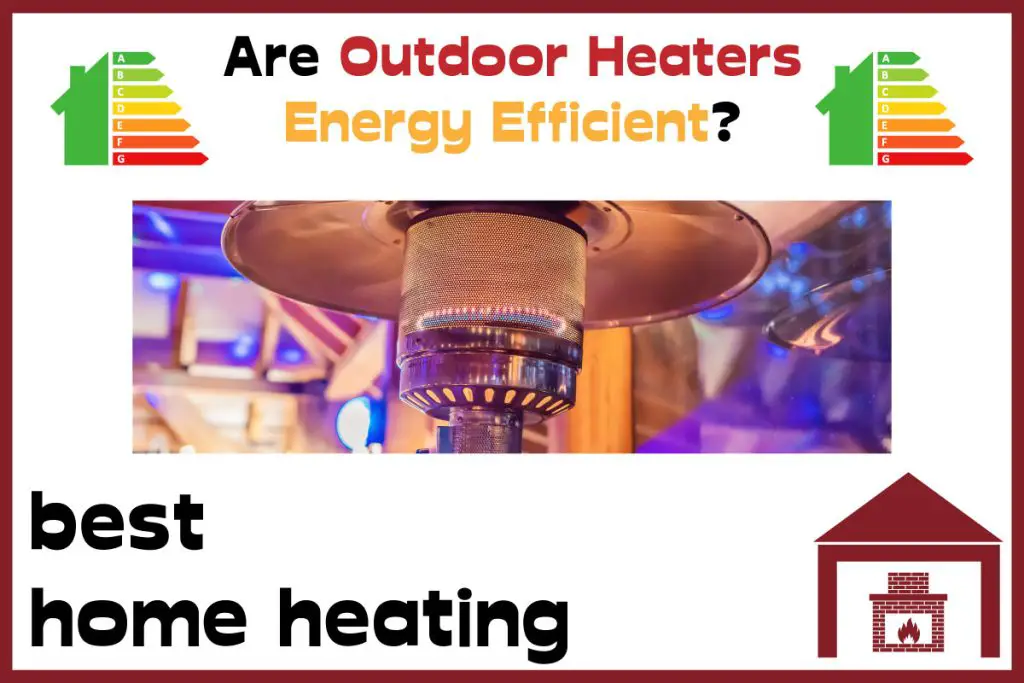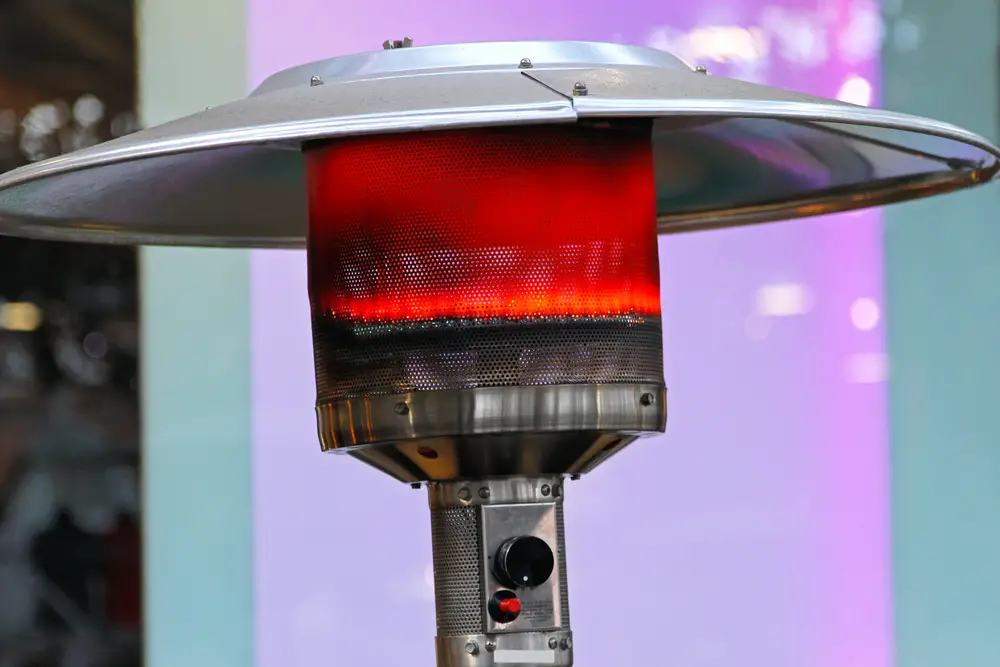The energy efficiency of outdoor heaters is an important factor to consider before you install them. So the question that arises is, how energy efficient are outdoor heaters at home? You would want to ensure that the heat energy given out is almost equal or equal to the energy consumed by the heater.
Modern Day electric outdoor heaters have a heating energy efficiency of between 85 and 98%. Electric Patio heaters for example have an average heating efficiency of 98% while Electric Infrared Heaters have an efficiency of 90%. On the other hand, solid fuels and gas heaters are about 1-2% efficient.
| Heating Device | Operating cost | Heating capacity | Possible to use indoors? | Environmental friendliness |
| Electric Heater | It costs 40p/hr to run a 2000W heater. | Modest | Yes | Yes (if using renewable energy) |
| Solid fuel Heater | It costs about $150-$200 per ton | Modest | No | No (it has fumes) |
| Patio Gas heaters | It costs 77p/hr to run a 3000W heater. | Highest | No | No |
| Fire pits | $0.80/hour | Modest | Yes but with chimney | No |
| Propane heaters | $4.23/hour | Highest | No | Yes but not as good as electric heaters |
For this reason, we would now go into detail on the various types of Outdoor heaters and the various factors to consider when picking one. Keep reading!

Different Types of Outdoor Heaters
Electric Heaters
These heaters are chic, vibrant, and available in a range of designs, including tabletop, freestanding, and wall-mounted models. Your outside spaces will stay warm during the fall thanks to electric outdoor heaters. Electric outdoor heat is a fantastic option for outdoor locations that lack the essential ventilation needed for natural gas or propane heaters.
The concept of electricity and water mixing is typical of utmost relevance when purchasing an outside item, such as a patio heater. Even in severe downpours, many modern patio electric heaters are well insulated and can be utilized. They also won’t deteriorate if left outside for an extended amount of time.
Electric patio heaters are not only very efficient, but they also don’t release any carbon dioxide into the atmosphere. So they can be used indoors too. Compared to gas patio heaters, electric heaters consume 85% less energy. Electric heaters are also completely odor- and toxin-free, which is quite advantageous. These silent heaters are also renowned for being very cost-effective, producing heat instantly with the simple flip of a button.
They typically cost £2.28 per hour for 52,000 BTUs to operate. BTU is a unit of heat that is defined as the amount of heat necessary to increase one pound of water’s temperature by one degree Fahrenheit.
Patio outdoor Heaters using Solid fuel
A solid fuel burner, which can take many different forms, including fire pits and log burners, is a kind of patio warmer. However, they typically employ a controlled fire made of wood logs or pellets. These types of heaters offer a campfire-like sensation and produce a nice ambiance for those seated around. They do, however, produce a lot of smoke, which, if inhaled for an extended period of time, can make you feel breathless, odorous (from the continuous stream of smoke), and generally pretty unhealthy.
People trying to stay warm around a fuel burner will find it less beneficial due to practical considerations. It takes some time for these kinds of garden heaters to ignite and reach a comfortable temperature. They are also far more difficult to keep running all night long and require continual upkeep. Additionally, they are less acceptable in professional situations where safety and health considerations could take precedence.
Though they cost less to buy they are more expensive to run than gas heaters.

Patio Gas Heaters
Over the past several years, gas patio heaters have unquestionably advanced and become greener than before. If you utilize a patio heater for your yard, these heaters may turn what was once used as a trash bin during the winter into a lovely, stylish new room that is connected to your home. You may use gas heaters on your patio in practically any weather because they can be found as outdoor wall heaters, outdoor heating lamps, and parasol heaters.
LPG burners are the most often used gas heaters and may be found in pubs, bar gardens, and smoking areas. These LPG burners are more costly than comparable models and use liquid petroleum. They are better suitable for bigger business contexts since they are often rather substantial and more expensive when compared to the cost of energy.
Since they produce heat by burning gas, they are not a suitable option for indoor use.
A 15000W gas heater typically costs £2.92 per hour to operate.
Fire pits
A firepit or a wood burner is the most basic type of outdoor heater. Despite their widespread popularity, they may dramatically increase air pollution. The amount of energy contained in the fuel and the water content of the fuel, in the case of wood fires, may both affect how much heat is generated.
The calorific value of dried wood is only around 15 Megajoules (MJ) per kilogram, but lighter, cleaner-burning charcoal has an efficiency of about 30 MJ per kilogram, which is higher than coal at 25 MJ per kilogram. The fuel will burn faster and emit fewer pollutants if the outdoor woodburning stove is efficient, but it may be pricey, and the performance will vary depending on the quality and dryness of the wood.
Fire pits can be used indoors too with a chimney. However, in this case, you may require a lid in front of the fire pit to avoid carbon dioxide entering the house.

Propane Heaters
For workplaces and job sites, outdoor propane heaters offer flexibility and rapid setup. These outdoor heaters are set up in minutes and begin producing lots of heat in just a few seconds. They are made to give direct, rapid heating with simple hook-ups to gas tanks.
The drawback with propane heaters is that a 20-pound gas tank is needed. When linked to an existing, direct gas line, some assembly, hook-up, and, in certain situations, expert installation is necessary.
Propane heaters are dangerous to use indoors.
Considerations for Choosing an Outdoor Heater
To guarantee that your outdoor heater operates as efficiently as possible, designers have considered the following aspects when proposing the mounting height and calculating the effective heating area:
The Temperature of the air
Infrared heat’s direct warming impact is less noticeable at lower air temperatures. Winter is the time of year when you need infrared heat to be comfortable. The effective heating area will be substantially bigger on a summer evening when the air temperature is approximately 15°C.
The Wind chill
Because your skin loses heat faster in a breeze, you need more infrared heat to feel comfortable in more exposed regions prone to air movement – not because infrared is less efficient in such circumstances.
Because there is greater air movement in the spring/autumn than in the summer, the effective heating area will be less. However, if you plan to use the heater in a relatively protected place or during the summer months, the effective heating area will be bigger.
Reducing wind is an excellent concept when trying to heat a vast open region. Using windbreaks wherever available will help insulate the space and hence retain heat. The wind has the greatest influence on heat and can divert it in the opposite direction from where it is needed.

Distance from the heater
The smaller the heating area gets as you get closer to the heater, the more strong the heating effect. As you walk away from the heater, the opposite happens. As a result, precise mounting heights are advised to obtain the best mix of coverage and comfort.
What distinguishes outdoor heaters from Interior Heaters?
Heating outdoor space involves distinct issues from heating inside space. Heaters must be safe in a variety of weather situations, and limiting the heat produced is a whole separate matter. The primary distinction between outdoor and interior heaters is that outdoor heaters often use infrared heating. Some interior heaters employ infrared heat as well, although the majority use convective heat.
Interior heaters warm a space indirectly by first warming the air surrounding the object and then transferring it by convection. This is why it is ineffective for outdoor purposes because the air would absorb the heat and spread it around before it gets to the intended recipients.
Outdoor heaters on the other hand transfer heat through infrared radiant energy through air molecules. The objects around absorb the air molecules, making the molecules of the object vibrate and increasing the heat of the object.
Conclusion
Most electric outdoor heaters have high heating efficiency. This is because they can transfer the heat they generate through direct means(infrared), as opposed to convection in indoor heaters. As a result, they have high higher efficiency.
Gas and other solid fuel heater are far less efficient than electric heaters. This is because the heat they generate rises up first before circulating to the intended target after a while.
Choosing the best outdoor patio heater is only one of the struggles to remain warm throughout the winter. By far the most effective way to increase outdoor warmth is to block the wind. Keep an eye on the wind direction as it passes through your land so that you can set up windbreaks wherever possible.
The following table shows a cost comparison among five types of heaters, which can better help you in making the right decision.
| Heating Device | Operating cost | Heating capacity | Possible to use indoors? | Environmental friendliness |
| Electric Heater | It costs 40p/hr to run a 2000W heater. | Modest | Yes | Yes (if using renewable energy) |
| Solid fuel Heater | It costs about $150-$200 per ton | Modest | No | No (it has fumes) |
| Patio Gas heaters | It costs 77p/hr to run a 3000W heater. | Highest | No | No |
| Fire pits | $0.80/hour | Modest | Yes but with chimney | No |
| Propane heaters | $4.23/hour | Highest | No | Yes but not as good as electric heaters |
